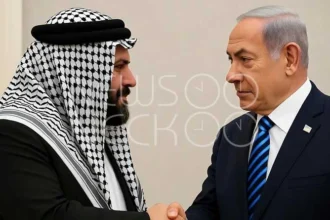A Bargain of Bodies and Bread: How a Dispute Over the Dead Threatens to Strangle Gaza’s Lifeline
In the fragile calm of a new ceasefire, a dangerous and morally complex standoff is unfolding. It is a dispute that pits the urgent need to feed the living against the profound duty to bury the dead. Just days after the world watched the joyful reunions of freed hostages and prisoners, the nascent peace is being tested by a grim accounting of the deceased.
Israel has announced a severe response to what it calls a violation by Hamas of the US-brokered ceasefire agreement. Because Hamas has been slow to return the bodies of all deceased Israeli hostages, Israel says it will now halve the number of aid trucks allowed into Gaza and keep a critical border crossing closed.
This decision threatens to choke the flow of food, water, and medicine to a population that aid agencies describe as starving and desperate. It reveals a simple, brutal equation at the heart of this conflict: the return of the dead has become a bargaining chip for the sustenance of the living.
The Breach and The Sanction
The crisis erupted just one day after a wave of hope swept through the region. On Monday, Hamas released the final 20 living Israeli hostages it held, and Israel freed nearly 2,000 Palestinian prisoners and detainees. But the agreement also stipulated the return of the bodies of hostages who had died.
Of the 28 deceased hostages, Hamas returned only four on Monday. This, Israel declared, was a “violation of the agreement”. In response, the Israeli military agency that coordinates such activities (COGAT) stated that starting Wednesday, only half of the previously agreed 300 aid trucks would be allowed to enter Gaza. Furthermore, the vital Rafah border crossing with Egypt will remain closed, and no fuel or gas will be permitted entry except for specific humanitarian needs.
The United Nations confirmed it has received notice of these planned cuts, with agencies on the ground pushing for the decision to be reversed. They warn that the “suffering prolongs for people in Gaza” with every day the crossings stay shut.
The Names of the Four
The four bodies returned have since been identified, putting names and stories to the abstract concept of “deceased hostages”.
- Guy Iluz, a 26-year-old Israeli, was taken from the Nova music festival. The Israeli military stated he was wounded during capture and later died due to a lack of medical care while in Hamas captivity.
- Bipin Joshi, a 22-year-old agriculture student from Nepal, was abducted from a kibbutz. It is believed he was murdered in captivity during the early months of the war. His teacher remembered him as “courageous,” and a friend credited Joshi with saving his life by throwing away a grenade during the attack.
- Yossi Sharabi was also identified after being returned. He was taken alive from his kibbutz, and the Israeli military had announced his death in captivity over a year ago.
For the families of the 24 hostages whose bodies remain in Gaza, the pain is compounded by frustration. The Hostages and Missing Families Forum called the situation a “blatant breach of the agreement” and stated that Hamas’s failure “must be met with a serious response”.
You Might Like it: Trump Hails ‘New Dawn’ in Israel Peace Push 2025:
A Collapsing Lifeline
The decision to cut aid threatens to plunge Gaza back into a humanitarian catastrophe. Even before this reduction, aid agencies were sounding the alarm. The Red Cross and UN agencies stated that the expected surge of aid after the ceasefire has not yet begun.
“The longer Rafah stays closed, the more the suffering prolongs for people in Gaza,” said Unicef spokesperson Ricardo Pires. A spokesperson for the International Committee of the Red Cross described a desperate scene of “only a few trucks coming in, and large crowds approaching these trucks in a way that does absolutely not conform to humanitarian standards”.
This is not a new crisis, but the escalation of a long-standing one. Earlier this year, the UN reported that Gaza was facing “the worst humanitarian situation ever seen,” with over two million people facing acute shortages of food, medicine, and clean water. The World Food Programme has previously reported running out of food stocks entirely, with bakeries closing and hunger spreading.
A Test for a Fragile Peace
This dispute over the dead now poses the first major test for the US-backed ceasefire plan. The agreement itself contains a mechanism for this scenario, stating that if all bodies are not returned, Hamas should provide information and “exert maximum effort” to fulfill its commitment. Both Hamas and the Red Cross have acknowledged the “massive challenge” of recovering bodies from the widespread rubble of Gaza.
The table below summarizes the key aspects of this unfolding situation:
| Aspect | Israel’s Position | Hamas & Mediators’ Position |
|---|---|---|
| Trigger | Hamas violated the truce by returning only 4 of 28 deceased hostage bodies. | Recovering bodies is a “massive challenge” amid Gaza’s destruction. |
| Action Taken | Halve aid trucks (150 instead of 300); close Rafah crossing; ban most fuel. | |
| International Response | UN confirms notice received; agencies warn of prolonged suffering and push for reversal. | |
| Human Impact | Worsens hunger and blocks lifeline for over 2 million people in desperate need. |
For world leaders who just days ago celebrated a diplomatic breakthrough, the path forward is fraught. The simple, powerful human joy of hostages and prisoners reunited with their families has been overshadowed. The difficult truth is that in this conflict, even in death, there is no easy peace. The task now is to ensure that the quest to honor the dead does not ultimately sacrifice the living.
Author: Yasir Khan
Date: 14 Oct, 2025
For More Updates, Visit Newsneck













